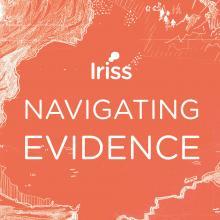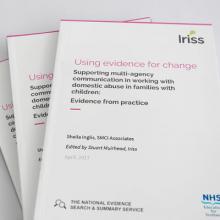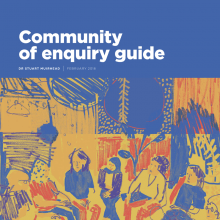This Insight looks at intensive supervision, surveillance and monitoring of young people.
This Insight was completed in partnership with Sarah MacQueen of the Scottish Centre for Crime and Justice Research (SCCJR) and Paul Rigby of the Criminal Justice Social Work Development Centre (CJSW).
Key points
- The Scottish Intensive Monitoring and Supervision (ISMS) programme and the English/Welsh Intensive Supervision and Surveillance Programme (ISSP) appear to reduce the frequency, severity and risk of offending in young people, although probably no more than other levels of supervision.
- These programmes may be rigorous and cost-effective alternatives to secure care appropriate for certain groups of young people, especially 'persistent' offenders.
- ISMS without a movement restriction order (MRC) may be as effective as the original model which included electronic monitoring
- Factors influencing the effectiveness of such interventions include support from management, being flexible in the support offered, the availability of high quality intensive support services, fast responses to crises and providing access to community resources and services.
- Further rigorous research is required to replicate these findings, which indicate far higher reductions in offending than any of the robust, gold standard, randomised control studies.
Introduction
In the UK, the use of suitable non-custodial disposals in the management of young offenders is a priority for both financial and ideological reasons. This evidence summary highlights evaluations of Intensive Monitoring and Supervision (ISMS) in Scotland and the Intensive Supervision and Surveillance Programme (ISSP) in England and Wales, interventions that include elements of intensive support, supervision and monitoring, including electronic monitoring (EM). We do not address programmes such as bail with EM and curfews with EM that do not include an intensive support component as the value of these has been questioned in previous research (eg Nellis, 2004a and 2004b).
Current Situation
ISMS
ISMS was piloted in seven local authorities in Scotland in 2005 and was rolled out nationally in 2008. ISMS was designed as a new option for the Children's Hearing System to provide an alternative to secure accommodation. It consists of a six-week assessment period, following which the young person may be assigned to an ISMS package with a movement restriction condition (MRC). In order for ISMS with an MRC to be imposed young people must meet the conditions outlined in Section 70 (10) of the Children (Scotland) Act 1995.
The MRC lasts up to six months and is accompanied by tailored intensive support; this continues for a similar period after the completion of the MRC. Though not the initial aim, intensive support is often given under the ISMS banner without the EM component and is referred to as Intensive Support Service (ISS) cases or ISMS without MRC. Good Practice Guidance on ISMS from Scottish Government (2009), currently being updated, suggests 'intensive support should be seen as a highly focussed, multi-agency, community based service designed to meet all the identified needs of our most complex, vulnerable and challenging young people and their families'. The Guidance suggests five essential components for a best practice ISMS: a range of structured intervention services; full time education and training opportunities; access to 24/7 support able to provide crisis support; respite and 'time-out' options; and the need to plan for continuity of support beyond the movement restriction condition, including a relapse prevention period.
Good practice guidance suggests that structured intervention services are one of the essential components of ISMS. However, a clear outline of what has constituted intensive support is lacking in the literature. It is suggested in Boyle et al (2008) that in practice this has been a mixture of informal befriending and structured work focusing on offending behaviour, substance misuse and relationships. There is no evidence currently to either support or critique the use of these practice methods.
ISSP
Introduced in 2001 in England and Wales, an ISSP generally lasts six months and combines intensive support of at least 25 contact hours per week for the first three months with strict surveillance (at least two checks a day), usually EM. The ISSP is described as the most rigorous non-custodial sentence available for young offenders in England and Wales.
Re-offending and risk of re-offending?
Evaluations of ISMS and ISSP are discussed below. For ISMS, the analysis is based on small groups of young people with no control group. Comparisons are made between measures prior to, during and after the interventions, rather than with an alternative or non-intervention group. For ISSP, a larger sample with a control group was analysed. The control group included those who were eligible for ISSP but received different interventions such as a supervision order (SO), community rehabilitation order (CRO) or detention and training order (DTO), without the ISSP component due to their location.
ISMS
The first two years of the ISMS programme was evaluated both nationally and locally. Data relating to reoffending was available for Dundee and Glasgow City. In Dundee, reductions of up to 70% were reported in several categories of offending for the six months post-intervention compared with the six months prior to the intervention. After 12 months, the reduction was 52%. There was also a reduction of 31% in risk of offending (Boyle et al, 2008). In Glasgow, Vaswani (2007) reported a 37% reduction in monthly offending, 28% for those on ISMS with MRC and 57% for those without MRC. Severity of offences committed fell by 19% (14% for ISMS with MRC and 33% for ISMS without MRC). Risk scores fell by only 6%, with little difference between those with and those without the MRC.
A two-year follow-up study (Vaswani, 2009) considered the longer-term effects of ISMS. At this time, half of all orders had included MRC. Compared to the six months prior to ISMS, offending reduced by 50% during the ISMS, by 45% in the six months post-intervention and by 57% in the longer term (18-24 months), suggesting sustained benefits of participation in ISMS. Importantly, those who had committed very few offences in the period prior to ISMS, showed an increase in offending. ISMS, therefore, may be less appropriate for those with a low initial level of offending.
While this evidence appears, overall, to be encouraging, there are a number of methodological limitations in the Scottish studies. For instance, Boyle et al (2008) acknowledge the lack of a control group against which to compare their results. Also there is no critique of their figures from Dundee City Council and no explanation of how these figures were calculated. The reports by Vaswani (2007, 2009) do allow the reader to see how the percentage reductions in reoffending have been calculated in Glasgow. It is stated that there are variances within the ISMS population that are masked by the use of the average volume reduction in offending for the population as a whole. Average volume reduction may not be the most appropriate way of examining patterns of offending behaviour or percentage changes in severity of offending and risk scores.
ISSP
Compared to 12 months prior to ISSP, frequency of offending showed a 43% reduction over one year (Moore et al, 2004), broadly maintained over the second year (Gray et al, 2005). Seriousness of offences also reduced by 13%, maintained over two years. However, Gray et al (2005) indicate significantly fewer offences were committed by the control group over the same period.
The ISSP study also examined reconviction over two years. This led to a much-quoted statistic of 85% of young people receiving ISSP being reconvicted at least once in one year (Moore et al, 2004) and 91% in two years (Gray et al, 2005). While these figures are high, researchers stress that the group receiving ISSP was very high risk and on average had committed 11.6 offences in the two years pre-intervention. Complete cessation of offending was therefore unrealistic: the reduction in frequency and severity of offending should be given more weight.
A genuine alternative to custody?
ISMS
Admissions to secure accommodation in Glasgow fell by 18% in the first two years of ISMS (Vaswani, 2007). In addition, 50% of those discharged from secure accommodation were referred directly to the ISMS team, increasing their protective factors on discharge. By 2009, secure admissions in Glasgow were 37% lower than when ISMS began.
Young people, their social workers and carers generally preferred ISMS to secure accommodation, but were less positive about the MRC element (Boyle et al, 2008). Two-thirds of Children's Panel members interviewed believed that ISMS was at least as effective as secure accommodation. These respondents felt that ISMS was more appropriate than secure accommodation for 'persistent offenders' and for younger children, whereas secure accommodation was seen to be the better solution for 'serious offenders' and those at risk of self-harming.
Children's Panel members and the police perceived ISMS as a genuine alternative to custody. Sheriffs were less convinced, but only limited data is available from this group. No respondents believed secure accommodation was a more appropriate disposal than ISMS, and around half said that while secure accommodation had a place, it should be a last resort. All social workers interviewed stated that they would recommend ISMS for future cases that met the secure care criteria (Vaswani, 2007).
Many of the young people included in the evaluation by Kahn and Hill (2007) had already been in secure accommodation prior to ISMS. These young people preferred ISMS, mainly because they had greater freedom but also, in some cases, because they received more support.
ISSP
While ISSP was not launched explicitly as an alternative to custodial sentencing, it came to be seen as a viable alternative by sentencers (Moore et al, 2004). Gray and colleagues (2005) note a very small reduction (around 2%) in the use of custody for young people since the introduction of ISSP but conclude that as similar reductions occurred in areas where ISSP had not been introduced, this cannot be attributed to the intervention. In addition, in some cases, ISSP was used instead of less intensive community disposals. There is a need to be alert to the possibility of an increased tariff as a result of the availability of intensive community services.
Cost-effective?
ISMS
In Glasgow, participation in ISMS costs around £1000 per week compared to more than £5000 per week for secure care (Vaswani, 2009). Despite the lack of detailed data, Boyle and colleagues (2008) conclude that the ISMS pilot provided cost savings due to lower use of secure accommodation. However, only immediate costs are assessed and it is unclear whether ISMS will be cost effective in the longer term.
ISSP
Estimates from the Youth Justice Board in 2005 showed that with an average cost of £12,000 per young person, ISSP compared favourably in terms of cost to secure accommodation (a year in a local authority secure children's home was around £192,154, a secure training centre around £174,550, and a young offender institution around £55,075). The ISSP evaluation (Gray et al, 2005) looked at different measures of cost-effectiveness. Based on the savings resulting from reduced offending, they estimate that the ISSP saved £80,000 in its first two years of operation compared to a saving in the comparison sample of £72,000. However, some of the comparison sample did receive custodial sentencing and this is not taken into account in their comparison so the true measure of cost-effectiveness may be higher.
Impact beyond offending?
Young people were divided on the effect of EM on their home life, though parents and carers viewed it more positively. Parents and carers perceived benefits as including helping to resist the influence of peers and avoiding conflict over curfews (Gray et al, 2005; Kahn and Hill, 2007; Boyle et al, 2008). The ISMS evaluations also point out disadvantages such as intrusiveness, restriction on parental activities and the presence in the house of the young person's friends. For some young people, difficulty was reported in using EM due to lack of suitable accommodation or family support (Boyle et al, 2008). The difficulties noted by young people in relation to electronic monitoring are serious and raise the question as to the suitability of an MRC in such circumstances.
Eighteen months post ISMS, while some young people experienced improved outcomes in regard to the attainment of qualifications, only 10 young people (n=38) were engaged in employment, education or training. Sixteen were unemployed and 7 were in secure accommodation or a YOI (Vaswani, 2009). While these figures are lifted from a small scale outcome study, it is clear that the young people involved in ISMS continue to present with complex needs post intervention.
The impact of support versus supervision
EM was a controversial element of ISMS that generated ideological concerns among professionals and subsequent difficulties with implementation (Vaswani, 2007; Boyle et al, 2008). These concerns lessened over time and with experience of the system, though they were still a significant issue. However, no respondents believed that the ISMS approach was mostly or entirely punitive. For those who felt that there were punitive elements, they believed that they were outweighed or at least equalled by welfare elements.
While more than half of Children's Panel members surveyed thought that ISMS with MRC was more effective than intensive support alone, in case studies social workers and carers attributed most of the positive effects of ISMS to the support component. Additionally, external intensive support service providers were seen as one of the most effective aspects of the ISMS programme both by stakeholders and Children's Panel Members (Boyle et al, 2008).
Khan and Hill (2007) report that most of Includem's intensive support workers recorded spending more time on ISMS cases with MRC than without. Despite this, both groups made similar progress in most areas, including re-offending. High quality intensive support can therefore be used effectively on its own as an alternative to custody. Nonetheless in some cases MRC had particular benefits, for example in giving the young person a credible reason for resisting negative peer influence and in supporting carers to assert rules more effectively (Gray et al, 2005; Kahn and Hill, 2007; Boyle et al, 2008).
It is clear that the introduction and implementation of ISMS received mixed responses from practitioners and stakeholders. Given the complexity of the needs of the young people involved, and the serious nature of the ideological and practical concerns raised during the initial phases of ISMS, it seems important to consider these issues in greater depth when weighing up the decision to use ISMS as a response to the problems of young people and their families.
Implications for policy and practice
Current evidence indicates that programmes involving both intensive supervision and surveillance may lead to some reduction in frequency and severity of offending. However, there are also suggestions that such programmes are no better than normal supervision in reducing offending behaviour. Secure care is seen as more appropriate for young people with 'serious' offending behaviour and also those at risk of self-harm or absconding. Alternative community sentences are likely to be more appropriate for those with lower initial levels of offending.
While effectiveness varies for different groups of young people, the nature of this variation is uncertain and cannot be determined from existing research. For example, in the ISMS evaluation, young women showed lower levels of compliance, attendance and a lower reduction in offending (Vaswani, 2007). The opposite trend was apparent in the ISSP group (Gray et al, 2005), with young women showing greater reduction in offending frequency and severity. Further investigation is required in this area.
Overall, while intensive interventions may be better suited for some young people as an alternative to secure care /custody, it is unclear whether they are more successful than other available community disposals at reducing offending, and whether there is added value in the surveillance component. Further investigation is required on this matter. Current evidence suggests that intensive support services are the most effective parts of the programme. The presence of a high quality (and possibly external) intensive support service provider is crucial to success. There is qualitative evidence that some of the young people and families regarded the EM component as having a particular role in facilitating resistance to peer pressure and supporting parental authority.
Research indicates that the success of ISMS and ISSP is dependent on key factors, including:
- high-level management support successful partnership working
- promotion of the intervention as a disposal where appropriate
- flexibility in the intervention to allow the needs of different types of young people to be met
- suitable housing or accommodation to allow EM to be implemented
- high quality staff on the scheme
- rapport building with young people
- provision of crisis support to young people and their families
- an element of tapered transitional support at the end of each order.
Finally, in order to maintain success, post-intervention protective factors in a young person's life should be increased. This can include providing access to community resources such as employment agencies, health agencies and constructive leisure opportunities along with initiatives such as participation in restorative justice (Gray et al, 2005; Boyle et al, 2008).
References
- Boyle J, Zuleeg F, Patterson K et al (2007) Insight 39: Evaluation of Intensive Support and Monitoring Services (ISMS) within the Children's Hearings System, Edinburgh: Scottish Government
- Boyle J, Zuleeg F, Patterson K et al (2008) Evaluation of Intensive Support and Monitoring Services (ISMS) within the Children's Hearings System, Edinburgh: Scottish Government
- Gray E, Taylor E, Roberts C et al (2005) Intensive Supervision and Surveillance Programme: The Final Report, London: Youth Justice Board
- Khan F and Hill M (2007) Evaluation of INCLUDEM'S Intensive Support Services, Glasgow: INCLUDEM
- Moore R, Gray E, Roberts C et al (2004) The Initial Report on the Intensive Supervision and Surveillance Programme, London: Youth Justice Board
- Nellis M (2004a) The 'tracking' controversy: the roots of mentoring and electronic monitoring, Youth Justice, 4, 77-99
- Nellis M (2004b) Electronic Monitoring and the Community Supervision of Offenders, in A Bottoms, S Rex and G Robinson (eds) Alternatives to Prison: Options in an Insecure Society, Cullompton: Willan
- Scottish Government (2009) Good Practice: Intensive Support and Monitoring, Edinburgh: Scottish Government
- Vaswani N (2007) ISMS experiences from the first two years of operation in Glasgow, Glasgow: Glasgow City Council
- Vaswani, N (2009) Intensive Support and Monitoring Service (ISMS): ISMS and Beyond, Glasgow: Glasgow City Council




